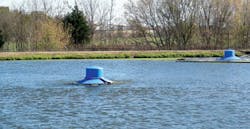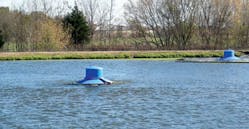By Chip Bettle
Almost every wastewater treatment plant produces a disposable biosolids stream that must be sent to a landfill, stored in lagoons or digested anaerobically.
Natural systems, however, do not take these options into consideration. They convert biosolids into gas and a small amount of ash, as well as create environmental niches where preferred organisms thrive, mostly one niche at a time. For example: aerobes create biosolids that sink; biosolids are liquefied and sequentially acidified and turned into gas; and worms consume residuals, harvest the biological oxygen demand (BOD) and excrete BOD-free, high N castings as alluvial silt.
The problem is that these processes work slowly and are easily overwhelmed. Observed another way, nature has developed a method to convert waste into gas and a benign soil amendment. Engineers are therefore tasked with increasing the capacity of these natural systems so that biosolids never require disposal.
Blackwater typically contains significant amounts of oil and grease, which inhibits microbial attacks by coating solids with a hard-to-digest layer of fat. This water also contains sulfate- and sulfur-reducing bacteria (SRB) -- the source of common rotten-egg sewer odors.
As a viable solution, the Blue Frog System from Absolute Aeration digests sludge in-situ by creating environmental niches in ponds so that waste can be attacked sequentially and without odor. As biosolids initially turn into gas and ash, violent upheavals mix the layered supernatant and cause upsets. Once sludge eruptions are eliminated, the system quiets down, and the effluent becomes clear.
The clear water, with a depth of 4 feet, is not gradual -- one day it is turbid, and the next is clear. When natural niches come into balance, however, "spring water" is created. The lagoons appear normal with superficial surface circulation, but substantial biochemistry is occurring beneath the surface, niche-by-niche. The surface is typically where aeration biochemistry occurs and where soluble BOD is rendered insoluble and biosolids sink.
The first step in the Blue Frog process is a high-shear/high-cavitation process that hydrolyzes oil and grease into fatty acid soap. This reduces surface tension by about 20 percent and creates granules that convert TSS into gas. The wetter water then purifies the berms so the solids fall to the bottom. The granules are the same ones created in up-flow anaerobic digesters, with the only difference being that they originate in ambient water and self-propagate throughout the lagoon.
The granules are an intricate, spherical, natural biofilm that uniquely eliminates hydrogen gas (H2) production. When H2 is not produced, hydrogen sulfide (H2S) is not produced, and the ponds have no odor.
Aerated, attached-growth media is provided to convert residual soluble carbon into attached biosolids. An entire ecosystem develops in this niche where worms and insect larvae consume the biosolids and convert them into castings. When the water is deeper than 7 feet, the bottom is below the photic zone and is naturally anaerobic, and granules digest the sludge. When the water is shallow, the surface of the sludge is aerobic, while the sludge itself is anaerobic.
Worms burrow headfirst into the anaerobic sludge while waving their tails in the aerobic water above the sludge bed to consume oxygen; this action distributes silt into the supernatant. Meanwhile, microalgae grow in the clarifying water. Zooplankton such as Daphnia consume residual TSS and microalgae, producing oxygen and TSS and clarifying the water column. The TSS then feeds the worms. Their silt is alluvial, BOD-free and high in Total Kejeldahl Nitrogen (not ammonia) and ultimately leaves the system as TSS.
With the Blue Frog system, the water clarifies, there is no odor, all permit limits are met, and the residual sludge level is about 4 inches. Further, the operation is simple: the operator does nothing except check that all equipment is running, change the gearbox oil annually and conduct sampling per schedule.
About the Author: Chip Bettle is Co-Inventor & Executive Vice President of Engineering for Absolute Aeration, LLC, Greeley, Colorado, USA. Chip is a chemical engineer who utilizes his unique perspective, straddling both science and engineering, to lead Absolute Aeration in process development. Chip designs complex, low cost solutions to meet regulated discharge requirements. As an inventor he has over 35 approved US patents.
For further information, contact Brandi Waters, Absolute Aeration Customer Service Manager at (386) 233.5074 or email: [email protected].
More WaterWorld Current Issue Articles
More WaterWorld Archives Issue Articles




